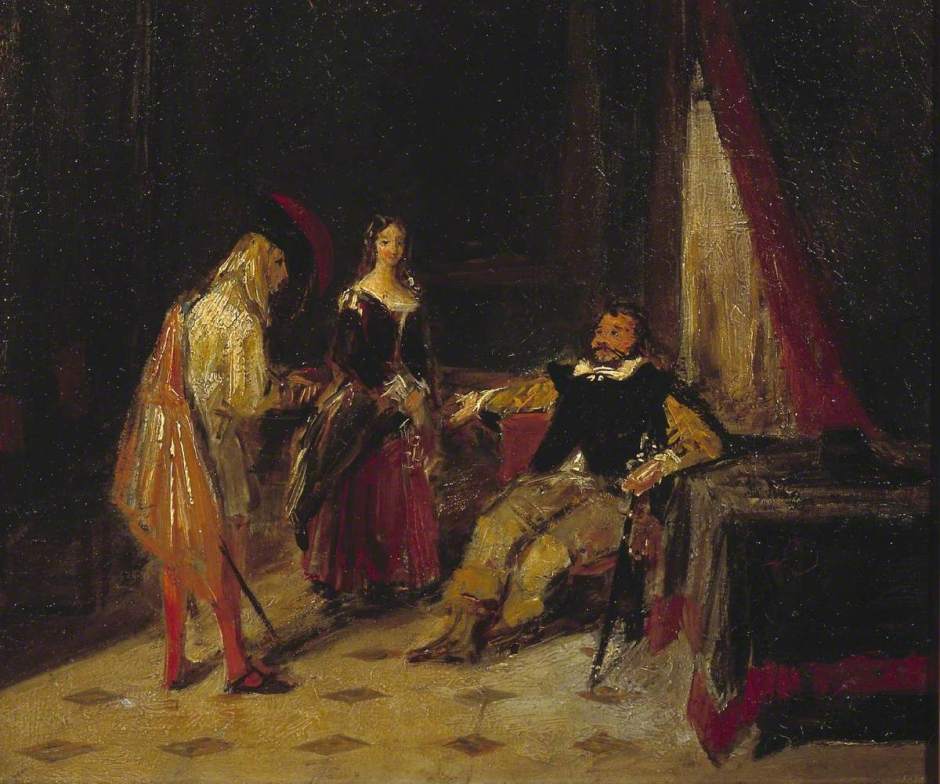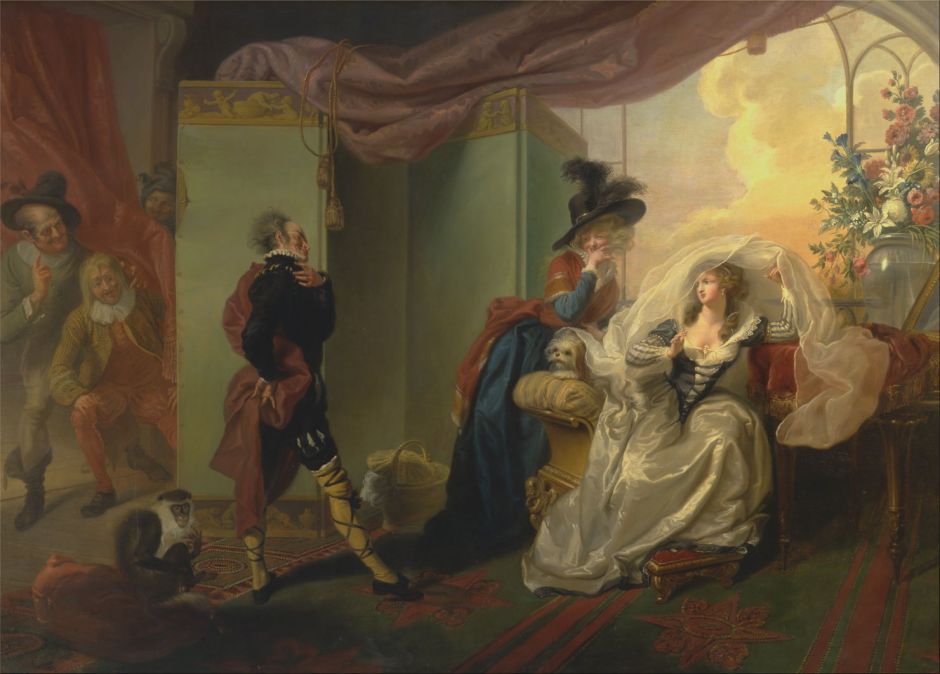Twelfth Night marks the end of the traditional English feast of Christmas, and William Shakespeare’s much-loved comedy Twelfth Night was probably written in late 1601 to be performed after the end of the festive season, early the following year, when its first recorded performance is dated. It has the alternative title of What You Will. Initially it proved very popular, and ever since has enjoyed periods of fashionability.
Its best-known character, Sir Toby Belch, is one of Shakespeare’s richest caricatures, and central to many of the paintings made of this play. These became popular late in the eighteenth century, and in a revival in the middle of the following century, but exclusively in Britain, reflecting its thoroughly English humour.
Orsino, Duke of Illyria, is in love with Olivia, but she rejects him. On the coast nearby, Viola has reached dry land after being shipwrecked, but fears her twin brother Sebastian has drowned. She hears of Orsino’s failed suit, and decides to pretend to be a eunuch and serve in the Duke’s court.
Sir Toby Belch, Olivia’s reprobate uncle, is at her house with another of her suitors, the inept Sir Andrew Aguecheek, who even fails to engage with the witty conversation of a servant.

Charles Robert Leslie’s oil sketch for Twelfth Night, Act I, Scene 3 (1841) shows the three talking, Aguecheek standing at the left, and Sir Toby Belch leaning back in a chair, although here the witty maid appears detached.
Viola, now posing as the eunuch Cesario, is sent by the Duke to woo Olivia as his proxy, but Viola has herself fallen for Orsino. Olivia’s clown Feste is in disgrace, and she sends him to look after her drunk uncle. Olivia’s steward Malvolio, no friend to Feste, tries to obstruct Cesario (Viola) from gaining access to his mistress, but she is eventually successful, and rebukes Olivia for her pride while praising her beauty. Although Olivia again rejects Orsino’s suit, she sends Malvolio after her with a ring she pretends was an unwanted gift from Orsino, in the hope of seeing Cesario (Viola) again.

William Powell Frith’s Olivia Unveiling from 1874 shows Viola in her disguise as a eunuch at the left, as the beautiful Olivia removes her veil.
Sebastian, who is alive and well after all, believes his twin sister Viola drowned in the shipwreck, and goes with his friend Antonio to the Duke’s court, where Antonio has enemies.
Malvolio gives Cesario (Viola) the ring Olivia claimed she had left behind, which makes her realise that Olivia has fallen in love with her, and she wonders how that will work out.

George Henry Hall’s full-length portrait of Sir Toby Belch from 1854 shows him earlier in the day, as it’s still light outside. His glass is on the table, as he has already been drinking.

William Hamilton’s The Carousing of Sir Toby Belch and Sir Anthony Aguecheek (1792) shows the pair singing together, with Maria in the background but without without Feste.
Late that night, Belch and Aguecheek get Feste the clown to sing the song “O mistress mine”. Maria, the witty servant, tells them off for being too loud, before Malvolio threatens Sir Toby that Olivia could banish him from her house.

George Henry Hall’s Malvolio Confronting the Revellers from 1855 shows Malvolio at the right, wearing his night-cap and telling the group off. From the left they are Sir Andrew Aguecheek, Feste the clown, Sir Toby Belch, and the maid Maria behind.
Once Malvolio has left, Maria plans her revenge, to give the steward a forged letter from their mistress declaring her love for him.
Orsino and Cesario (Viola) discuss love, and she defends women from the charge of being more fickle than men. The Duke sends her back to Olivia to try again.

Walter Deverell’s Twelfth Night, Act II, Scene IV (1850) elaborates on their discussion, with Feste the clown singing to them.
Maria the maid has placed her forged letter in Malvolio’s path, as he walks through the garden, with Belch, Aguecheek, Maria and another servant hiding to observe his reaction. The steward is already dreaming of marrying Olivia and becoming Count, and is completely fooled by the letter. It urges him to spurn Sir Toby Belch, to smile in a manner quite out of character, and to wear cross-gartered yellow stockings as signs of his love for Olivia. The others hurry away to await Malvolio’s transformation.
Cesario (Viola) meets them as she’s on her way to Olivia. Once they’re alone together, Olivia confesses her love for Cesario (Viola), but Viola says that she can only pity Olivia, who then pretends she could yet love the Duke, in a bid to get Cesario to return.
Sir Toby persuades Sir Andrew that Olivia is offering him a chance if he can prove his valour. Instead of abandoning his suit, Aguecheek goes off to write his challenge to Cesario. They then hurry away to see Malvolio in his gaudy new stockings.
Sensing he is in danger because of his previous involvement in a fight at sea against the Duke, Antonio gives Sebastian his purse to carry, and tells him to meet later at an inn.
Olivia is taken aback by Malvolio’s appearance, with his cross-gartered bright yellow stockings, and when he uses phrases from the forged letter, she presumes he has gone mad.

This climax in the comedy is shown in Johann Heinrich Ramberg’s Olivia, Maria and Malvolio from 1789. Malvolio is in the left foreground with his distinctive cross-gartered yellow stockings, and Olivia at the right raises her veil in disbelief at the sight. Behind her is Maria, stifling a laugh, as her fellow conspirators watch from the extreme left.

Daniel Maclise’s painting of Malvolio and the Countess (1840) is my favourite of this play, and shows the same three characters, with the suggestion of the others hiding in the middle of the scene, beyond the overgrown wall.
Olivia leaves to meet Cesario (Viola), and Sir Toby, Maria and the other servant next speak to the steward as if he’s possessed.
Sir Andrew’s written challenge to Cesario is so cowardly Sir Toby insists he delivers it in person.
Viola asks Olivia to love the Duke rather than Cesario. When Olivia has left, Sir Toby sets up a duel between Sir Andrew and Cesario, but soon after they start fighting with their swords, Antonio arrives and mistakes Cesario for his friend Sebastian. Antonio is just about to fight with Sir Toby Belch when officers arrive to arrest Antonio, who then asks Cesario to return his purse, about which she knows nothing; it is her brother Sebastian who has that. Antonio is taken off to prison, Viola now hopes that her brother is still alive, and Sir Andrew pursues her, as Cesario, intent on renewing his challenge.

William Powell Frith’s undated painting of The Duel Scene from ‘Twelfth Night’ shows the four about to fight with their swords before being interrupted by Antonio’s arrest.
Meanwhile, Sebastian meets Feste the clown, who mistakes him for his sister Viola in disguise as Cesario. When Sir Andrew makes the same error, he strikes him, forcing Sebastian to retaliate and to take on Sir Toby as well.

Arthur Boyd Houghton’s Sir Toby Belch Coming to the Assistance of Sir Andrew Aguecheek from about 1854 shows the two in a fist-fight with Sebastian.
Olivia then arrives to make the same mistake. She leaves with Sebastian, delighted that he is responding so well to her advances at last.
Malvolio is declared insane and locked away in a darkened cell. When Feste the clown visits him, he agrees to bring him writing materials so he can write a letter to Olivia.

Olivia and Sebastian have lost no time in their courting, and he agrees to get a priest to marry them immediately, as seen in William Hamilton’s Olivia’s Proposal from about 1796.
Feste takes Malvolio’s letter for Olivia. Duke Orsino arrives with his court, including Cesario (Viola), and Antonio is brought before them. Fortunately, the Duke remembers his valour, but is put off by Antonio’s claim that Cesario (mistaken for Sebastian) has been in his company, rather than in the Duke’s court (as Viola in disguise).
The arrival of Olivia interrupts their confused discussion. Orsino admits that her affection for him has been replaced by that for Cesario, and threatens to kill his rival. Viola declares her love for the Duke, and Olivia produces the priest who declares that she and Cesario are now married. Next to arrive are Sir Andrew and Sir Toby, the latter wounded in his fight with Sebastian. They are astonished to see Cesario/Viola (or Sebastian) there, and when Sebastian arrives shortly afterwards and apologises to his new wife Olivia for wounding her uncle, all are baffled to see what they thought of as one person is actually two.
Gradually the separate identities of the two siblings are confirmed, and Viola says that her womanly clothes are being cared for by the captain of their ship. However, Malvolio has had him arrested; the steward is summoned, as Malvolio’s obviously sane letter to Olivia is read aloud.

Frederick Richard Pickersgill’s double portrait of Orsino and Viola was painted in about 1850. Appropriately, it’s unclear whether she is here Cesario or her real self.
Duke Orsino agrees to marry Viola. Malvolio arrives and shows Olivia the forged letter he found in the garden. Feste and a servant confess to the forgery, and reveal that Sir Toby Belch and Maria have married.
Malvolio leaves, vowing his revenge, but the Duke directs that he has Viola’s clothes returned to her for their wedding. With that Feste sings an epilogue.
References
Wikipedia on Shakespeare’s play.
Full text at Project Gutenberg.
Michael Dobson and Stanley Wells (eds) (2015) The Oxford Companion to Shakespeare, 2nd edn, Oxford UP. ISBN 978 0 19 870873 5.

